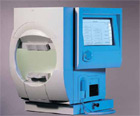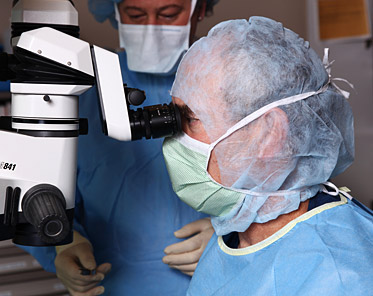Glaucoma Treatment and Surgery

Glaucoma refers to a common eye condition that causes damage to the optic nerve. The causes may vary, but in most instances it is associated with higher than normal pressure within the eye. The only proven treatment for glaucoma is to lower the eye pressure further. This is most commonly done with eye drops, which are usually very successful in stabilizing the optic nerve.
Diagnosis and Evaluation
Glaucoma is diagnosed and followed using a variety of examination techniques. The optic nerve is viewed directly and evaluated by the doctor in the examination room.
The optic nerve structure can be evaluated further using imaging techniques such as photography, optical coherence tomography (OCT) and optic nerve topography (HRT.) These automated devices allow analysis and followup of optic nerve structure and are helpful at distinguishing low risk from high risk optic nerves.

The optic nerve function can be evaluated by visual field testing. The standard is the Humphrey Visual Field Analyzer which maps out the sensitivity to white light of the central 30 degrees of the field. It has an excellent statistical software package incorporated into it that helps track the optic nerve function, looking for change or deterioration with time.

The Zeiss Frequency Doubling Technology is a quick and sensitive instrument to screen and monitor visual field loss.
Glaucoma Treatment
Medications
There are several classes of modern anti-glaucoma drops available. The most commonly prescribed are the prostaglandins (Xalatan, Travatan, Lumigan.)
Beta blockers have been used for several decades and are convenient and generally safe and well tolerated, although they may be riskier in patients with cardiac or pulmonary problems.
Other topical medications such as alpha agonists (Alphagan, brimonidine) or topical carbonic anhydrase inhibitors (Trusopt, Azopt) can be effective.
Medications can be used singly or in combination. There are fixed combinations of medications (Cosopt: Trusopt and beta blocker, Combigan: brimonidine and beta blocker) which can be effective and convenient.
Laser
If medications prove inadequate, additional pressure-lowering can often be achieved by laser treatment such as laser trabeculoplasty (LTP). Laser light is directed to treat the internal drainage areas of the eye which is quite effective at lowering the pressure in most individuals. The effect may tend to diminish with time.
Surgery
Surgery is often the most effective way to lower pressure and is usually indicated when deterioration occurs despite the use of medication and/or laser treatment. There are a variety of operations and techniques, but the most commonly preformed glaucoma surgery is the trabeculectomy procedure. In this operation a new fluid pathway is created to allow a new flow of fluid from the front chamber of the eye to a fluid collection usually under the upper eyelid. Anti-healing medications are often used to reduce the chance of postoperative scarring. The operation is performed as an outpatient under local anesthesia. Because healing is variable, careful follow-up is usually required for several weeks after surgery.
